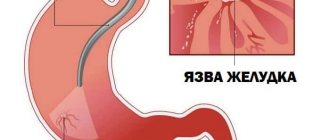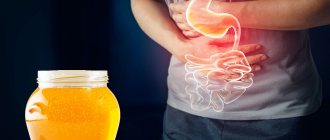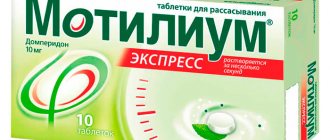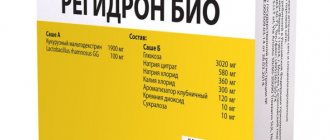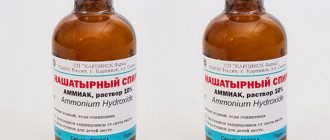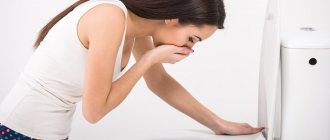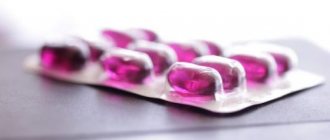Why do you feel sick after taking antibiotics?
Antibiotics travel throughout the digestive tract, causing negative effects on all areas. Some drugs are less toxic: penicillins, macrolides, so they have fewer side effects, while others provoke serious disorders: aminoglycosides, tetracyclines, fluoroquinolones.
The appearance of a feeling of nausea after taking antibiotics occurs due to the negative effect of medications on:
- Stomach. Antimicrobial drugs, once in the stomach, are destroyed, causing irritation of the walls of the organ, which provokes nausea and subsequent vomiting. To avoid this, the product is coated with a coating that dissolves in the intestines. But this only partially reduces stomach irritation.
- Liver. After consuming any drug, the liver breaks it down into elements acceptable to the body. Antibiotic components increase the load on this organ during absorption, reducing efficiency. Therefore, cell death occurs and the production of digestive enzymes decreases. Due to the inability to digest incoming food, nausea begins, followed by vomiting.
- The pancreas produces an enzyme important for digesting food - pancreatin. Antimicrobial drugs negatively affect gland cells, reducing the production of the required amount of enzyme. This makes it difficult to digest food, leading to nausea and vomiting.
- The intestines are also negatively affected due to the use of antibiotics. Thus, drugs in tablets, capsules or suspensions cause irritation of the walls, reducing functionality. In addition to pathogenic bacteria, beneficial intestinal microflora is eliminated. Because of this, food is not digested or absorbed, which leads to rotting and fermentation. The result is intoxication of the body, causing nausea and vomiting.
Development mechanism
As is known, most antibiotics can lead to significant changes in the quantitative ratio and qualitative composition of the intestinal microflora. Opportunistic and pathogenic microorganisms begin to prevail. Scientists associate the appearance of vomiting and diarrhea from antibiotics with a decrease in the number of bacteria sensitive to antibacterial drugs and the emergence of resistant microorganisms that are normally absent.
As clinical studies show, the most common cause of gastrointestinal disorders due to dysbiosis are gram-positive bacteria from the genus Clostridia (in particular, Clostridium difficile). At the same time, other microorganisms can also provoke vomiting in a child and diarrhea associated with the use of antibiotics. Increased secretion of electrolytes and water, as well as the release of toxins and damage to the intestinal wall can be expected from:
- Staphylococcus.
- Enterobacteriaceae.
- Enterococci.
- Yeast mushrooms.
- Klebsiella.
- Pseudomonas aeruginosa.
Which antibacterial drugs most often cause side effects in children such as nausea, vomiting and diarrhea:
- Ampicillin.
- Lincomycin.
- Benzylpenicillin.
- Lincomycin.
- Cephalosporins.
- Erythromycin.
- Tetracyclines.
I would like to note that it does not matter much how the antimicrobial agents were introduced into the body. The medicine taken orally is not limited to the destruction of bacteria, but also affects the intestinal mucosa. In the case of intravenous or intramuscular administration, the antimicrobial drug affects the microflora and mucous membrane of the digestive tract when it is excreted in the bile and secretions of the small and large intestines.
When your child begins to vomit and go to the toilet frequently, especially after taking antibiotics, the best thing you can do is call a doctor as soon as possible.
Rules for taking antibiotics
How successful the treatment will be depends on the correct diagnosis and the correct prescription of drugs. It is required to strictly follow the dosage regimen and regimen specified by the manufacturer in the instructions. Observe the time of administration: during meals or after finishing a meal - this indicates possible irritation of the stomach walls by the drug, so it should not be taken on an empty stomach. Special attention should be paid to drug interactions.
Taking alcohol with antibiotics is prohibited.
Nutrition
Antibiotics should not be used on an empty stomach; they irritate it. The presence of food reduces the absorption of drugs in the stomach. Recommended dietary intake:
- fresh porridge on water;
- lean fish or meat, steamed, boiled or baked;
- soups;
- baked fruits and vegetables;
- omelette.
In this case, you need to avoid foods that lead to fermentation:
- sweets, baked goods, candies;
- canned or pickled foods;
- from fruits: pears, plums, apricots;
- flour products from bread to pasta;
- smoked products;
- fatty meat, fish;
- fat milk, cottage cheese;
- spicy and fried.
When taking antibiotics, you need to drink plenty of fluids. In addition to ordinary water, compote, jelly, rosehip infusions, and green tea without sugar are allowed. If vomiting or diarrhea occurs, increase the amount of drink to prevent dehydration.
Associated symptoms
In addition to pain in the abdominal area, dysbiosis can manifest itself as stool disorders, increased gas formation, and there are clear signs of dyspepsia, allergies, and anemia. Uncontrollable diarrhea is common in young children.
Dysbacteriosis in infants is quite common. It appears when, for some reason, after passing through the birth canal, the child does not receive a full set of all the necessary bacteria. In this case, the child begins to suffer from constant diarrhea from the first days of life. This is very dangerous, as the baby loses water at a rapid rate. In older children, dysbiosis manifests itself in the form of diathesis, rashes on the shoulders and face, and constipation.
Medicines for antibiotics
Taking antibiotics destroys beneficial bacteria in the digestive system, reducing its efficiency. By eliminating pathogenic microflora, poisons and toxins are formed that negatively affect the digestive system and the body. Therefore, additional medications are required.
Sorbents
To reduce the chance of occurrence and eliminate nausea with vomiting, sorbent preparations are used. They neutralize the negative effects of toxins and poisons and remove them from the body. But due to the fact that, in addition to pathogenic elements, these agents bind and reduce the effect of antibiotics, administration is carried out at intervals of 2 hours. Recommended to take:
- Polysorb;
- Enterosgel;
- Smecta;
- Activated carbon.
Probiotics
To prevent intestinal dysbiosis, after antibiotic therapy, start taking probiotics from the first day. These products contain beneficial bacteria that increase immunity, thereby creating conditions for restoring normal microflora of the gastrointestinal tract. Probiotics restore bacterial balance and the effectiveness of antimicrobial treatment. These include:
- Linux;
- Bifidumbacterin;
- Bifiform.
dietary supplements
Taking medications containing beneficial bacteria reduces the likelihood of side effects from antibiotics. Additionally, they suppress the growth of pathogenic microflora by increasing the production of beneficial bacteria that eliminate nausea, cramps, pain and vomiting. For this we recommend the following method: Narine.
Take the following types of medications as prescribed by your doctor:
- enveloping agents that protect the walls of the gastrointestinal tract from irritation: Diosmectite;
- food enzymes that normalize digestion: Mezim, Pancreatin;
- antacid drugs used for high acidity: Almagel;
- hepatoprotectors that restore damaged liver cells: Essentiale;
- rehydration products to restore water-salt balance: Regidron.
If nausea and vomiting occurs in a child, you should immediately consult a doctor. Self-treatment is fraught with dehydration and poses a danger to the baby’s life. The doctor will rinse and prescribe another antibiotic suitable for the child.
Treatment
To cope with vomiting and diarrhea that a child has experienced after taking antibiotics, it is necessary to carefully select a new course of treatment, which will be aimed directly at combating the developed dysbiosis and dehydration, as well as restoring normal microflora and intestinal motility. Complex therapy should include all available modern therapeutic agents that make it possible to quickly cope with side effects from the previous use of antibacterial drugs.
Antibiotic therapy
What should you do first? It is recommended to immediately stop using antibiotics that caused vomiting and diarrhea in the child. To eliminate clostridia, which, according to most authors, are considered the main culprits of dysbacterial disorders in the intestines, Vancomycin and Metronidazole are prescribed. The dosage and frequency of medications are selected individually. The therapeutic course lasts on average 1–1.5 weeks. Bacitracin may be used and treatment lasts approximately 7–10 days. It has been established that practically no absorption occurs, therefore a high concentration of the drug is observed in the large intestine.
It should be noted that the new course of antimicrobial drugs is prescribed solely for indications in order to suppress the growth of pathogenic bacteria in the intestines that cause vomiting and diarrhea in the child. It is advisable to use drugs that have minimal impact on normal microflora and suppress the growth and reproduction of aggressive microorganisms. In such cases, they resort to the following:
- Intetrix.
- Enterola.
- Baktisubtila.
- Nifuroxazide.
If a child experiences fairly severe diarrhea and vomiting from antibiotics, it is necessary to stop taking the medications and adjust the treatment.
Prebiotics
You can get rid of dysbiosis associated with the use of antibiotics, and with it vomiting and diarrhea, with the help of drugs from the group of prebiotics. Using metabolic products of normal bacteria (prebiotics), we have a detrimental effect on pathogenic microflora. One of these drugs is Hilak-forte, which has the following effects:
- Restores the natural biological environment in the intestine, necessary for the functioning of normal bacteria.
- Inhibits the growth and reproduction of pathogenic and opportunistic microorganisms.
- Helps improve the trophism and function of the intestinal epithelium.
More than 100 billion beneficial bacteria are contained in one milliliter of this drug. Hilak-Forte must be taken for at least 4 weeks in combination with or after antibiotics.
Eliminate dehydration
Considering the severity of dehydration that can develop in a child due to prolonged vomiting and diarrhea, rehydration therapy is required to restore water and electrolyte balance. For mild to moderate dehydration, oral rehydration is used. Fluid and electrolytes in the child’s body are replenished by drinking special solutions. Currently, oral rehydration may include the administration of:
- Glucose-electrolyte solutions.
- ORS (oral rehydration salt).
- Oralita.
- Regidrona.
- Citroglucosolan.
For example, today Regidron is considered one of the most popular water-electrolyte balance restorers. This drug quite quickly replenishes the necessary reserves of ions in the body. The dosage and frequency of administration are prescribed by the attending physician, taking into account the child’s weight, the severity of dehydration and the amount of vomiting and diarrhea. Strict adherence to the dose of the drug allows you to avoid serious side effects. Since an overdose of Regidron can lead to weakness, confusion, problems with heart function, convulsions, decreased muscle tone, etc.
In the absence of special solutions for oral rehydration, it is recommended to prepare the solution at home. It includes the following ingredients:
- Half a teaspoon of regular salt (about 2.5 grams).
- You will need 30 grams of sugar, which corresponds to 6 teaspoons.
- A liter of boiled water.
If moderate and severe dehydration is noted, it is necessary to carry out parenteral rehydration, which consists of intravenous administration of polyionic solutions. As a rule, they resort to prescribing medications such as Trisol, Kvartosol, Laktosol and their analogues. When the patient begins to produce more urine than feces during the last 6–12 hours, he is switched from parenteral to oral rehydration. The effectiveness of rehydration therapy is assessed according to the following clinical criteria:
- The patient's well-being improves markedly.
- Blood pressure stabilizes.
- The heart rate decreases.
- Vomiting stops.
- Diuresis is restored.
- The main blood test parameters are normalized.
In approximately one in three patients, antibiotic-associated diarrhea appears 5–8 days after stopping antimicrobials.
Restoration of microflora
At the final stage of treatment, they restore normal intestinal microflora. To do this, it is necessary to use drugs from the group of probiotics. Actively and widely used:
- Bion 3.
- Linux.
- Bifidumbacterin.
- Baktisubtil.
- Florin Forte.
- Probifor.
For the treatment of vomiting and diarrhea that have developed as a result of the use of antibiotics, a probiotic such as Linex is often prescribed, which is a combination drug that contains components of normal microflora from various parts of the digestive tract. Thanks to the presence of bifidobacteria, lactobacilli and lactic acid enterococci, the balance of the intestinal biocenosis is maintained. If Linex is used in the recommended dosage, no side effects are observed. It can be prescribed simultaneously with antibacterial drugs.
Source: elaxsir.ru
Folk remedies
To eliminate vomiting and nausea resulting from taking antibiotics, traditional medicine is used. However, their use is agreed with the attending physician to select compatible components. Often used:
- Potato juice made from grated potatoes. Drink 1 tablespoon when nausea occurs;
- Apple vinegar. Dilute 1 teaspoon of vinegar in 100 ml of boiled water, drink if nausea occurs;
- Mint infusion. Brew 2 tablespoons of dry mint leaves in 250 ml of boiling water. Strain and take 2-3 sips to relieve nausea.
Additionally, unsweetened green tea helps eliminate negative symptoms.
Prevention
To prevent the development of digestive disorders due to taking antibiotics, it is necessary to follow the rules of treatment: take accompanying medications to maintain the functioning of the gastrointestinal tract and adhere to a diet. Do not overload the stomach or take excessive amounts of fatty and fried foods. The diet should consist of light meals containing a high amount of fiber, which will simplify digestion during treatment.
The appearance of nausea and vomiting as a result of taking antibiotics is the body’s reaction to damage to the walls of the digestive system by the components of the drug. To prevent such symptoms, you must adhere to the rules for taking antimicrobial medications, and, if they occur, eliminate them with medications or folk remedies.
Desensitization
Treatment for this type of allergy also includes desensitization. But it is used during long-term therapy and only when it is not possible to get rid of the reaction by other means.
Gradually the dosage will increase, which will force the body to get used to it. But manipulations are carried out exclusively under the supervision of the attending physician.
The method has one significant drawback - it will not be possible to completely get rid of an allergic reaction to antibiotics, but it is possible to reduce sensitivity. The duration of treatment is up to five years. If no changes are noticed within 24 months, therapy is discontinued.
